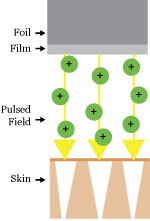Hate Needles? No Problem
New pulse-patch system could make vaccines cheap, fast, and easy
| From Explorations | By Mark Dwortzan
 Mark Horenstein (left) and David Sherr examine a prototype of their nano-pulse patch, which would deliver drug-laden nanoparticles through the skin.
Photo by Kalman Zabarsky
Mark Horenstein (left) and David Sherr examine a prototype of their nano-pulse patch, which would deliver drug-laden nanoparticles through the skin.
Photo by Kalman Zabarsky
 High-frequency sound waves interact with an emulsion containing polymer, medicament, and fluorescent dye to form spherical nanoparticles, which are then harvested, charged, and applied to foil-backed film. After applying this film to the skin, a pulsed electric field opens pores and drives nanoparticles toward the waiting dendritic cells.
High-frequency sound waves interact with an emulsion containing polymer, medicament, and fluorescent dye to form spherical nanoparticles, which are then harvested, charged, and applied to foil-backed film. After applying this film to the skin, a pulsed electric field opens pores and drives nanoparticles toward the waiting dendritic cells.
For all the advances of modern medicine, today’s drug and vaccine delivery methods still have their drawbacks: hypodermic needles, medicated patches, and ultrasonic methods may offer a range of options, but all lack speed and precision. (Not to mention that needles can hurt.) Since the dawn of modern medicine — well, maybe since the days of Star Trek — doctors and patients alike have wished for an easy, injection-free option: the device goes on your arm, and like that, you’re done.
Now a team of Boston University researchers is developing just that: an electrostatic nano-pulse method for rapidly delivering vaccines and drugs through the skin.
Funded in its pilot stage by BU’s Center for Integration of Medicine & Innovative Technology, the team aims to develop a clinical device with widespread applications, including low-cost inoculation in developing countries and rapid antidote dispersal in the event of an epidemic.
The idea — conceived by principal investigators Mark Horenstein, a College of Engineering professor of electrical and computer engineering, and David Sherr, a School of Public Health professor of environmental health — is to put a drug or vaccine inside a biodegradable nanoparticle as small as a human pore. Then, an electrostatic voltage pulse drives it through the skin, where dendritic cells carry it to the lymph nodes and generate the immune system’s response.
 Drug-laden nanoparticles (seen through a scanning electron microscope).
Drug-laden nanoparticles (seen through a scanning electron microscope).
 Fluorescent dye (shown under UV light) helps track the movement of nanoparticles through the body.
Fluorescent dye (shown under UV light) helps track the movement of nanoparticles through the body.
Sherr has developed plans to evaluate the nano-pulse method in laboratory mice by tracking fluorescent nanoparticles and adjusting the pulse strength. “If we can get the nanoparticles at about one-fifth the depth of a typical human hair and into a layer of skin called stratum corneum,” he says, “that layer has a direct line to the lymph node system.” The team will soon embark on a six-month pilot study to test the concept.
But challenges include the current. Horenstein, who’s developing the electrostatic nano-pulse technique, is trying to design a device that will drive nanoparticles into the skin with fewer than fifty volts of electricity, the maximum level thought to be safe for human subjects. “Usually when you’re trying to drive particles with this level of force, you need thousands of volts,” Horenstein says. “So it all comes down to designing the right methods and structures.”

 Twitter
Twitter Facebook
Facebook
Post Your Comment